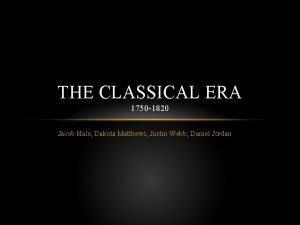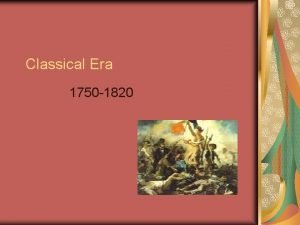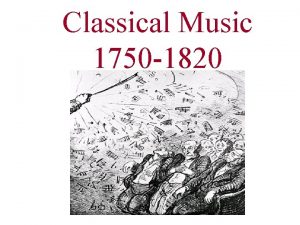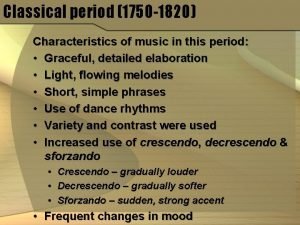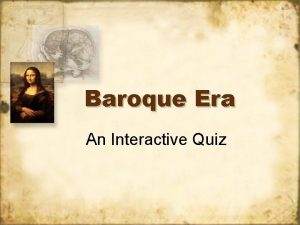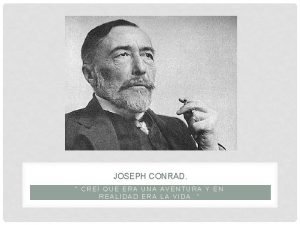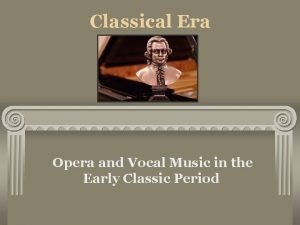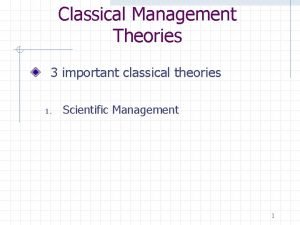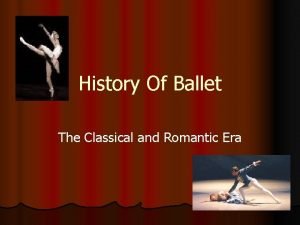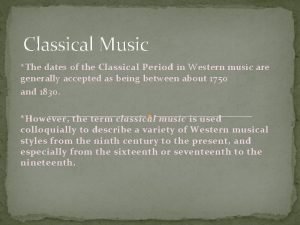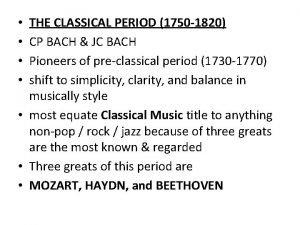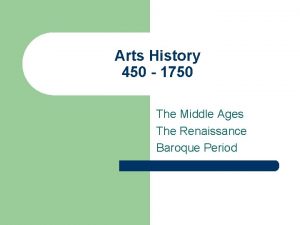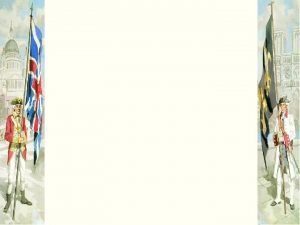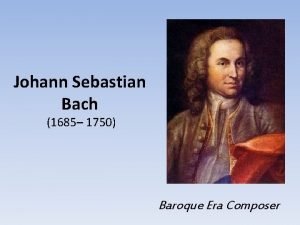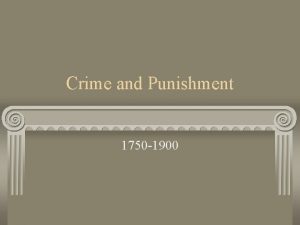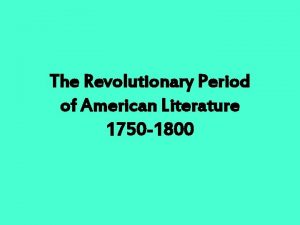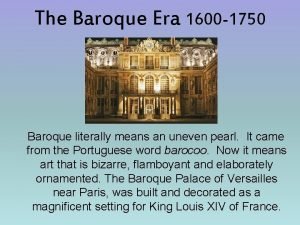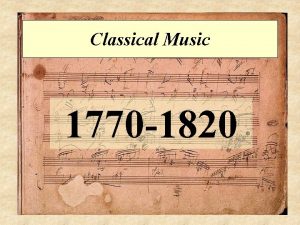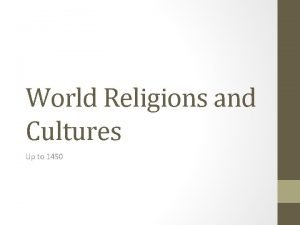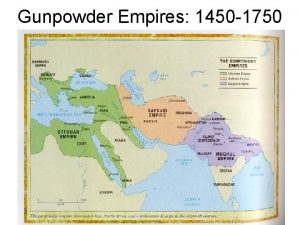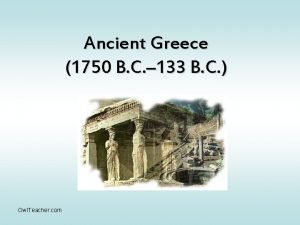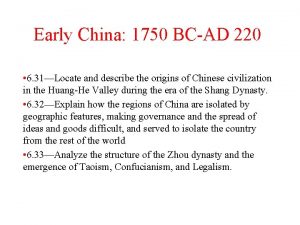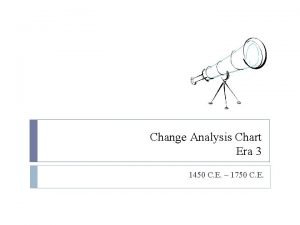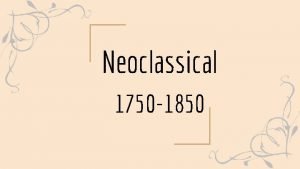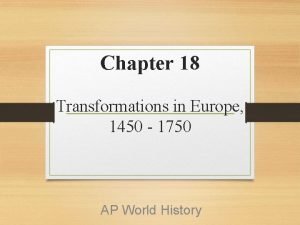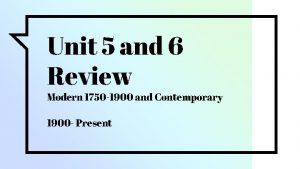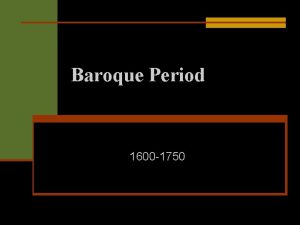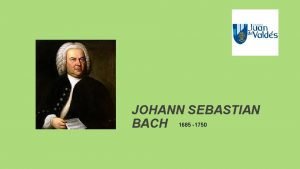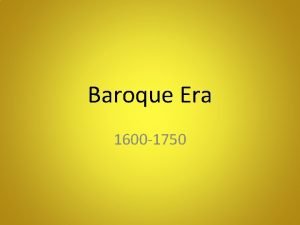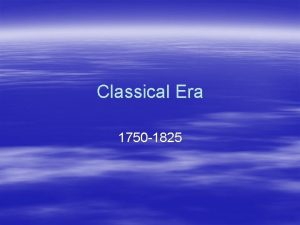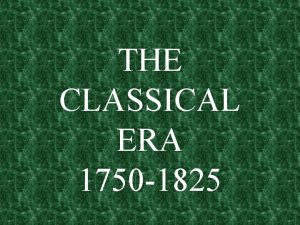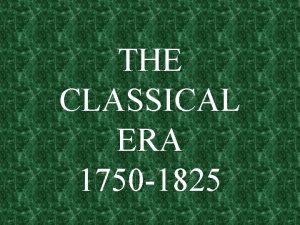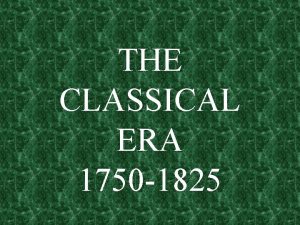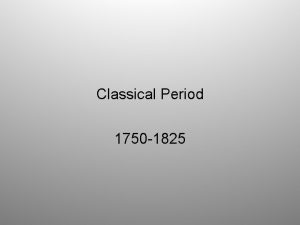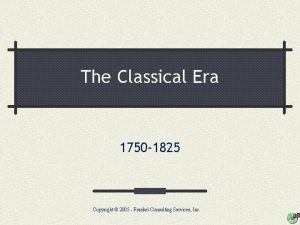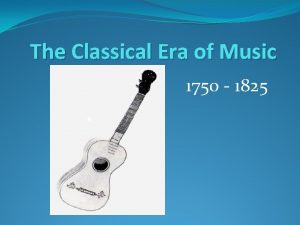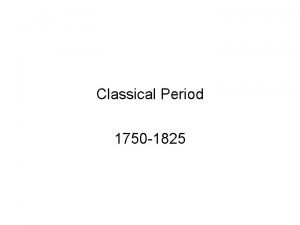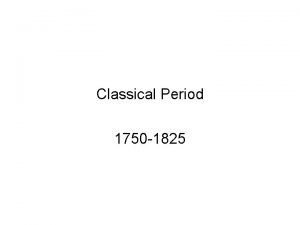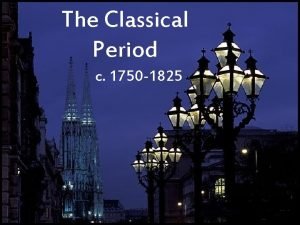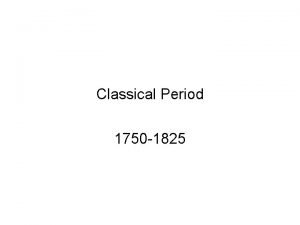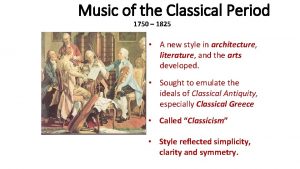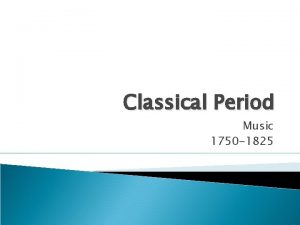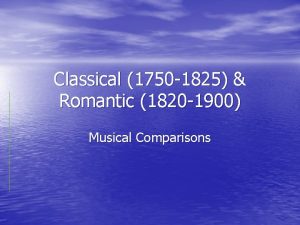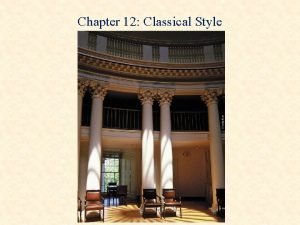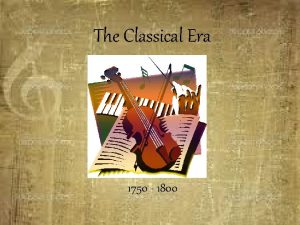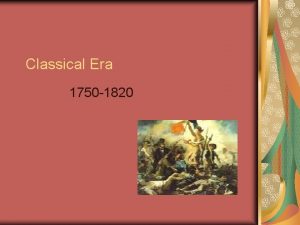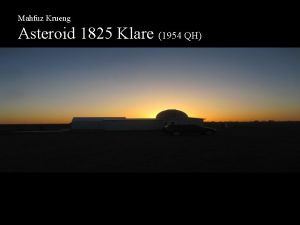The Classical Era 1750 1825 What is Classical



























































- Slides: 59

The Classical Era 1750 -1825

What is “Classical Music”? Describe thoughts and feelings you experience when you hear the term “Classical Music”. “When I hear the term ‘Classical Music’, I think/I feel…”

Well… In actuality, the term “Classical” applies only to aspects of art from a specific time period (about 1750 -1825 A. D. ), so it’s possible that we have been using incorrect vocabulary for most of our lives…

Goals 1. To become acquainted with the historical context of the Classical period and how it affected the development of music in the time period. 2. To become aware of the different styles of music in use in the Classical period and of the development of new forms. 3. To become able to describe some of the basic characteristics of Classical music using appropriate vocabulary terms.

Terms American revolution French Revolution Louisiana Purchase Napoleonic Wars War of 1812 Age of Reason Nationalism Symphony String Quartet Sonata Theme and Variation Aria

What was happening around the world? 1751 - Benjamin Franklin “discovers” electricity. 1775 -1781 - American Revolution 1789 - George Washington inaugurated 1789 -1795 - French Revolution 1803 - The Louisiana Purchase 1804 - Napoleon crowns himself Emperor. 1812 -1814 - War of 1812 1822 - The Rosetta Stone is deciphered

Famous People of the Era King Louis XIV of France Napoleon Bonaparte of France George Washington of America

Louis XIV

Napoleon

George Washington

Famous Classical Artists Fransisco de Goya John Constable Eugene Delacroix Jean-Honore Fragonard





What does the term “Classical” mean? From 1750 on artists, musicians, and architects wanted to get away from the opulence of the Baroque period and move to emulate the clean, uncluttered style of Classical Greece. This period is called Classical because of that desire to emulate the works of the ancient Greeks.

Characteristics of the Classical Period Historians have labeled the time around 1650 -1790 or so “The Age of Enlightenment” or the “Age of Reason”. The Enlightenment advocated reason as a means to establishing an authoritative system of aesthetics, ethics, government, and even religion, which would allow human beings to obtain objective truth about the whole of reality.

The Church and Monarchs were no longer the principle benefactors of the arts due to the political upheaval in Europe at the time. The aristocracy were the main patrons of the arts. They wanted impersonal but tuneful music from their composers. This led to the term “absolute” music which is music that is written for music’s sake.

Most of the Classical artists of all types were employed by various wealthy patrons. Most of their work was written as commissions, including music.

The center of Classical music was Vienna, which is where all of the major composers lived and worked. There was also a sense of Nationalism (love of a specific country) growing in many forms of art, including music.

Vienna

Musical Characteristics Great attention to musical form Use of dynamics as thematic material Inclusion of percussion instruments Strong sense of tension and release Use of modulation (going to a new key) Opera

Use of comic, witty and tuneful melodies Invention of the modern Piano (1709), as well as evolution of many other instruments Music in Europe continued to evolve towards greater sophistication: https: //www. youtube. com/watch? v=YJj 49 Tik. Zx. I as evidenced by this Mozart work from 1776. Music in America was growing in popularity and influence in rousing the population to nationalistic feelings, as shown in this Revolutionary War hit “Chester”: https: //www. youtube. com/watch? v=t 7 S_07 E-9 CA

New Forms Symphony Sonata String Quartets Theme and Variations

The Symphony An extended, multi-movement work for full orchestra - usually 20 - 40 minutes in length. Mastered by Franz Joseph Haydn - he wrote 104 of them. Usually contains three or four movements which contrast each other. In a four movement symphony the order usually is a fanfare type or fast opening movement, followed by a slower movement. The third movement is usually a dance, and the final movement is fast.

The Symphony Orchestra

The Sonata Form A one-movement piece for a solo instrument, usually accompanied by a piano - as opposed to a concerto, which is a multi-movement piece accompanied by an orchestra. There are three sections of a sonatan n n Exposition Development Recapitulation All sonatas follow this form. https: //www. youtube. com/watch? v=x 7 x. PIye Pm. Nk

The String Quartet A composition for four solo string instruments: n 2 Violins n 1 Viola n 1 Cello Each part is equally important. Haydn was the first to write one - he also mastered them. “Father of the String Quartet”. His quartets were mostly intended for background music at parties, so he often “snuck” in ideas that would not be accepted in larger styles. Piece usually has four movements similar to that of the symphonic form. https: //www. youtube. com/watch? v=vcr. Kz. Q 1_2 R 4

Opera While opera was invented much earlier in musical history, it was during this period and the one that followed that many of the most famous operas were written. One important change in opera was that the libretto (the storyline) was no longer expected to be just about gods, heroes and legends. Three of the most famous operas of this period are: n The Magic Flute n The Marriage of Figaro n Don Giovanni

All of these operas were written by Mozart. A selection from “The Marriage of Figaro” https: //www. youtube. com/watch? v=B Ltq. Zewjwg. A Operas of the time were also famous for arias, solos for expert singers

The Opera

Theme and Variation Taking an initial musical idea and expanding on its potential. This Mozart melody is a perfect example: https: //www. youtube. com/watch? v=DDMv vel. PXj 0

Famous Classical Composers Christoph Willibald Gluck (17141787) Franz Joseph Haydn (1732 -1809) Wolfgang Amadeus Mozart (17561791) Ludwig Von Beethoven (17701827) Franz Schubert (1797 -1828)

Franz Joseph Haydn

Haydn Spent most of his life as a servant to the Esterhazy family. Father of the string quartet, master of the symphony form (he wrote 104 symphonies!!). Was a mentor to many young composers, earning the affectionate nickname “Papa” Haydn. “Surprise Symphony, No. 94”-written with a musical joke to make audiences stay awake during after-dinner concerts.

https: //www. youtube. com/watch? v=VOLy 6 Jx. ED Lw In one summer, the Esterhazy family stayed longer at their country estate than normal, so Haydn composed a symphony in which the players each blew out their candles one-by-one and left the stage in the growing darkness as the music grew softer. The head of the Esterhazy family took the hint and sent all of the servants back to Vienna the next day.

Wolfgang Amadeus Mozart

Mozart Wolfgang Amadeus Mozart was a son to Leopold, an accomplished composer and violinist. Mozart and his sister—Nannerl—both displayed early talents for performing, so their father took them on concert tours of the royal courts of Europe.

Mozart started composing at about age 4 and had written a full symphony by age 8, an opera by age 12, etc. In his life he composed over 600 works, including 18 masses, 10 operas, 27 piano concertos, and 41 symphonies. Mozart resented the class system that kept him a servant to nobles. He frequently argued with his patrons and tried to become an independent composer in Vienna…a situation that high society was not ready to accept.

Mozart’s music was mostly light, elegant and tuneful…quite easy to hum in most cases!! Mozart’s most well know works include the melody we call “Twinkle, Twinkle Little Star” and the waiting music in the gameshow “Jeopardy”.

Mozart died young (age 35). His death remains a mystery, though some have speculated that his raucous lifestyle led to a failing of his liver…being poor, he was buried in a pauper’s grave. Mozart’s influence on later composers was so profound it is likely that the entire world of music would have been different if Mozart had lived longer and composed more.

Mozart Listening “Eine Kleine Nachtmusik”—A Little Night Music https: //www. youtube. com/watch? v=Qb_j. QBgz. U-I In a famous scene from “The Shawshank Redemption”, Mozart’s music helps prisoners transcend the confines of blank walls… https: //www. youtube. com/watch? v=Bjqmg_7 J 53 s His last symphony, No. 41 “Jupiter” https: //www. youtube. com/watch? v=z. K 5295 y. EQ MQ

Ludwig Von Beethoven

Beethoven Ludwig was born the son of a poor chorus singer. His father was determined that Ludwig could be another Mozart and make money for the family while still a young boy. He forced Ludwig to practice many long hours and would often come home late and wake the boy to give impromptu concerts for he and his drunken friends. Legend says that while still young, Ludwig travelled to Vienna where he met Mozart for a music lesson. Mozart is reputed to have said, “Keep your eye on him; one day he will give the world something to talk about. ”

Beethoven was as intense in his personal life as he was in his music. He apparently had affairs with many rich, influential women. He also had a long battle with one of his brothers over custody of his nephew. The family rift was never healed. Beethoven refused to be a servant to anyone and made a comfortable living as an independent composer. “Why bow to social status? ”--Beethoven

Beethoven’s music is intense and seems initially simple…usually just a few notes start a piece. His genius lies in what he was able to do with just those few notes. Beethoven’s music also expressed more direct emotion than had been favored by Classical era patrons…until they heard his pieces performed, then they too were swept away by the power of the music.

Much of the growing passion in Beethoven’s music could be attributed to his growing deafness. His rage at losing his hearing just as his compositional powers were at their height gave his works even more power to affect the spirit of the listener. With works growing longer as well as more expressive, Beethoven only wrote 9 symphonies. His music actually helped create a welcoming atmosphere for the emotional indulgences of the music of the next time period.

Beethoven Moonlight Sonata A masterpiece of simplicity expanded into emotional brilliance… https: //www. youtube. com/watch? v =Os. OUciky. GRk

Beethoven Fur Elise One of the most well-known pieces in all of piano music… https: //www. youtube. com/watch? v=z. O _xjz. HZ 0

Beethoven Symphony 5, Movement 1 https: //www. youtube. com/watch? v=z. M 3 y 09 Rj. KL s Listen as Beethoven uses just 4 notes to create an entire movement of a symphony. This was also the first symphony to use trombones (they were usually reserved for masses and operas because they were thought to have a sinister sound).

Beethoven Symphony 6 “Pastorale”, Movement 1 This work evokes (calls to mind) the scenes out of the window of a carriage during a ride on a pleasant spring day… https: //www. youtube. com/watch? v=tc. Su. Sk 4 d 6 Gs

Beethoven Symphony 7, Movement 2 https: //www. youtube. com/watch? v=Kb. NGk l. Nz 8 Yk Listen as Beethoven uses just a few notes to outline an entire movement by adding subtle layers of sound (theme and variation).

Beethoven Symphony 9 Considered by most music historians to be the greatest musical work yet written by man. The first movement begins with sounds that seem to be the orchestra just warming up and tuning their instruments, then the audience is struck by chords of immense power. Listen to a few minutes of the first movement: https: //www. youtube. com/watch? v=0 EC 1 t. XCE 3 C g

Beethoven Symphony 9, Movement 2 This movement includes a fugue worthy of Bach. The movement was so popular that at the premier of the entire symphony the crowd gave the 2 nd movement a standing ovation. Beethoven could not hear the applause (being completely deaf) and kept trying to get the orchestra to start the 3 rd movement. He grew more furious as the players just sat there doing nothing until one of them finally stood up and turned him around so that he could see the audience already standing and cheering for just the 2 nd movement out of 4. Of note are the sudden timpani hits, unheard of in the time. https: //www. youtube. com/watch? v=Tn 4 lk 8 f. Rsk. A

Beethoven Symphony 9, Movement 3 Quietly passionate, it displays a reserve unusual in this period of Beethoven’s life. Listen to just a bit of it to get a chance to rest your ears before the big finale… https: //www. youtube. com/watch? v=F 2 a. Eik Ki. Gcc

Beethoven Symphony 9, Movement 4 The first time this movement is encountered in a classroom setting, it should be listened to in small pieces over two or three days, both for its length and for its variety of sounds. The 4 th movement starts with a musical “review” of the previous three movements (something never done before) before starting a new journey.

The piece proceeds in “normal” fashion for some time before coming to a complete halt to introduce a new element: singers (another first in a symphony). The section with singers includes several full chorus moments as well as solos and quartets, etc. The entire orchestra and chorus unite for an outpouring of musical joy unlike any before or since, bringing the work to a close that leaves audiences roaring with approval. 4 th Movement

Beethoven Symphony 9, 4 th Movement Choral words taken from Friedrich Schiller’s poem “Ode to Joy” Joy, thou beauteous godly lighting, Daughter of Elysium, Fire drunken we are ent'ring Heavenly, thy holy home! Thy enchantments bind together, What did custom's sword divide, * Beggars are a prince's brother, * Where thy gentle wings abide. Chorus Be embrac'd, ye millions yonder! Take this kiss throughout the world! Brothers—o'er the stars unfurl'd Must reside a loving father.

Conclusions-the big takeaway… Many of the most famous composers in history come from this era. By 1825, the modern orchestra was almost fully in place (except for the tuba and low woodwinds). It was during this era that many of the most famous pieces of music were written, including symphonies and operas. Tracing the careers of Haydn, Mozart and Beethoven also parallels the development of the ideas of freedom in the world in this time. Haydn was content to be a servant; Mozart wanted to be independent but society was not ready for such a thing, and Beethoven succeeded in being independent of any need for the approval of nobles to make his music.
 What period lasted from 1750-1825?
What period lasted from 1750-1825? 1750-1825
1750-1825 Music of the classical period (1750 to 1820)
Music of the classical period (1750 to 1820) Jacob pertl
Jacob pertl 1820-1750
1820-1750 Music of classical period 1750 to 1820
Music of classical period 1750 to 1820 Classical period characteristics
Classical period characteristics Thaumatrope中文
Thaumatrope中文 Opanaf 1825/2018
Opanaf 1825/2018 Ab 1825 supervisor definition
Ab 1825 supervisor definition 17 novembre 1825 a neuchâtel
17 novembre 1825 a neuchâtel Era uma estrela tão alta era uma estrela tão fria
Era uma estrela tão alta era uma estrela tão fria Era quiz: the baroque era
Era quiz: the baroque era Elizabethan vs victorian
Elizabethan vs victorian Creí que era una aventura y en realidad era la vida
Creí que era una aventura y en realidad era la vida Opera & classical vocal music
Opera & classical vocal music Classical management era
Classical management era Classical music era timeline
Classical music era timeline What are the approximate dates of the baroque period
What are the approximate dates of the baroque period Classical era of ballet
Classical era of ballet Stele of hegeso
Stele of hegeso Classical music period dates
Classical music period dates Post classical era timeline
Post classical era timeline Ottoman empire 1815
Ottoman empire 1815 1820-1750
1820-1750 Middle ages nobles
Middle ages nobles Puhelaulunomaisia
Puhelaulunomaisia North america 1750
North america 1750 1685 1750
1685 1750 Rotary district 1750
Rotary district 1750 Clivarin 1750
Clivarin 1750 Crime and punishment 1750 to 1900
Crime and punishment 1750 to 1900 Linea de tiempo de 1750 a 1950
Linea de tiempo de 1750 a 1950 Revolutionary period of american literature
Revolutionary period of american literature 1600 hairstyles
1600 hairstyles St basil's cathedral ap world history
St basil's cathedral ap world history 1820-1750
1820-1750 Religion 1450-1750
Religion 1450-1750 Koloniale uitbreiding na 1750
Koloniale uitbreiding na 1750 Land based empires 1450 to 1750
Land based empires 1450 to 1750 Mughal empire 1450 to 1750
Mughal empire 1450 to 1750 Southeast asia 1450 to 1750
Southeast asia 1450 to 1750 Ancient greece 1750 b.c-133 b.c answers
Ancient greece 1750 b.c-133 b.c answers Barroco 1600 a 1750
Barroco 1600 a 1750 Japan 1450-1750
Japan 1450-1750 Fur trade 1450 to 1750
Fur trade 1450 to 1750 Neoclassical (1750–1850)
Neoclassical (1750–1850) 1750 bc ancient china
1750 bc ancient china Change analysis chart 1450 to 1750
Change analysis chart 1450 to 1750 Neoclassical (1750–1850)
Neoclassical (1750–1850) 1750-1820
1750-1820 Europe 1450
Europe 1450 1750-1900 portfolio map
1750-1900 portfolio map Convict food
Convict food 1750-1600
1750-1600 What does baroque mean
What does baroque mean Decline of russian empire 1450 to 1750
Decline of russian empire 1450 to 1750 Johann sebastian bach obras destacadas
Johann sebastian bach obras destacadas (http://www.youtube.comwatch?v=afhpriozexe)
(http://www.youtube.comwatch?v=afhpriozexe) 1770s music
1770s music



